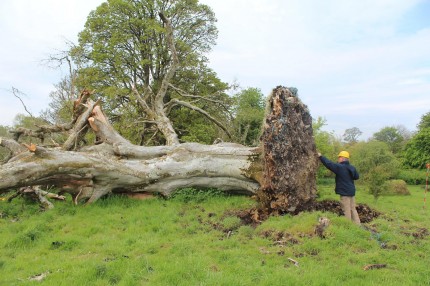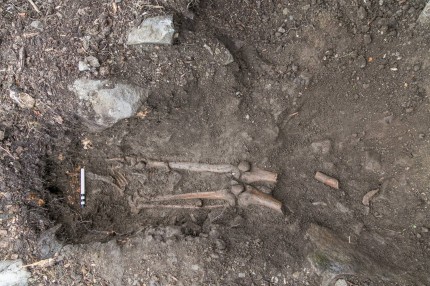
The newly established Sligo-Leitrim Archaeological Services (SLAS) had a fasinating first commission: to recover skeletal remains torn out of the ground when a tree was uprooted during a storm.
The beech tree had stood outside Collooney, County Sligo, Ireland, for 215 years before a storm blew it down last winter, pulling out the roots and the top half of a skeleton with them. The body was snapped in two when the tree toppled, leaving both femurs broken while the lower legs remained undisturbed in the grave. The National Monuments Service hired SLAS to excavated the remains in the ground and to painstakingly remove the bones embedded in the tree’s root matrix. The found part of the skull and spine in the roots, but other bones were destroyed by the roots as the tree grew.
Preliminary analysis of the bones by osteoarchaeologist Dr Linda Lynch revealed that the deceased was a young man 17-20 years old when he died. Radiocarbon dating found he was buried between 1030 and 1200 A.D. While a strapping 5’10” tall in a time when the average height was 5’5″, the youth suffered mild spinal joint disease likely caused by heavy physical labour from a young age. There is evidence on the bones that he did not die an easy death. Sharp force injuries on the ribs and hand point to his having been cut repeatedly with a knife or sword.
He was given a formal Christian burial. His grave was aligned east-west and he was placed in the grave with his hands folded over his pelvic region. There are records from the 19th century that describe a church and graveyard nearby, but no other human remains or archaeological evidence of a church were found during the excavation. Also, the tree was planted in 1800, so any graveyard in the environs of the medieval body probably wasn’t in its immediate surroundings. He may have been an isolated burial rather than one of many buried in a cemetery.
The skeletal remains will studied in more depth and post-excavation work on the site continues.
